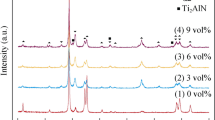Ti-Al-based multifunctional composite materials are widely analyzed for their outstanding properties—ultra-lightweight, high strength, high temperature, and corrosion resistance. Due to these special and unique properties, the new composite materials are widely used in various applications such as water filters, medical equipment, high-performance gas turbine engines, automobile and aerospace industries, and elsewhere. This work aims to determine the formation of MAX phases involving different systems for samples of TI-Al-C composites of a defined composition based on the research conducted by scientists.







Similar content being viewed by others
References
K. Kothari, R. Radhakrishnan, and N. M. Wereley, “Advances in gamma titanium aluminides and their manufacturing techniques,” Prog Aerosp Sci, 55, 1–16 (2012).
X. Yuan, Y. Cong, Y. Yu, et al., “Unique graphitized mesophase carbon microbead@niobium carbide-derived carbon composites as high-performance anode materials of lithium-ion battery,” Electrochim Acta, 238, 112–119 (2017). https://doi.org/10.1016/j.electacta.2017.04.020
P.-C. Gao, W.-Y. Tsai, B. Daffos, et al., “Graphene-like carbide derived carbon for high-power supercapacitors,” Nano Energy, 12, 197–206 (2015). https://doi.org/10.1016/j.nanoen.2014.12.017
G. Yushin, E. N. Hoffman, M. W. Barsoum, et al., “Mesoporous carbide derived carbon with porosity tuned for efficient adsorption of cytokines,” Biomaterials, 27, No. 34, 5755–5762 (2006). https://doi.org/10.1016/j.biomaterials.2006.07.019
J. Gonzalez-Julian, “Processing of MAX phases: from synthesis to applications,” J Am Ceram Soc, 104, 659–690 (2021). https://doi.org/10.1111/jace.17544
A. D. Bazhina, A. S. Konstantinov, A. P. Chizhikov, et al., “Materials based on the MAX phases of the Ti-Al-C system obtained under combustion and high-temperature shear deformation,” Mater Lett, 318, 132196 (2022). https://doi.org/10.1016/j.matlet.2022.132196
L. Ye, Z. Liu, S. Li, et al., “Thermochemistry of combustion reaction in Al–Ti–C system during mechanical alloying,” J Mater Res, 12, 616–618 (1997).
P. Eklund, M. Beckers, U. Jansson, et al., “The Mn+1AXn Phases: Materials Science and Thin-Film Processing,” Thin Solid Films, 518, 1851–1878 (2010). https://doi.org/10.1016/j.tsf.2009.07.184
M. Radovic and M. W. Barsoum, “MAX phases: bridging the gap between metals and ceramics,” Am Ceram Soc Bull, 92, No. 3, 20–27 (2013).
M. W. Barsoum and M. Radovic, “Elastic and mechanical properties of the MAX phases,” Annu Rev Mater Res, 41, No. 1, 195–227 (2011).
W. Sun, S. A. Shah, Y. Chen, et al., “Electrochemical etching of Ti2AlC to Ti2CTx (MXene) in low-concentration hydrochloric acid solution,” J Mater Chem A, 5, 21663–21668 (2017).
M. Shekhirev, C. E. Shuck, A. Sarycheva, and Y. Gogotsi, “Characterization of MXenes at every step, from their precursors to single flakes and assembled films,” Prog Mater Sci, 120, 100757 (2021).
H. Shao, S. Luo, A. Descamps-Mandine, et al., “Synthesis of MAX phase nanofibers and nanoflakes and the resulting MXenes,” Adv Sci, 10, No. 1, 2205509 (2022).
V. T. Witusiewicz, B. Hallstedt, A. A. Bondar, et al., “Thermodynamic description of the Al–C–Ti system,” J Alloy Compd, 623, 480–496 (2015). https://doi.org/10.1016/j.jallcom.2014.10.119
S. V. Sleptsov, A. A. Bondar, V. T. Witusiewicz, et al., “Cocrystallization of Max-phases in the Ti-Al–C system,” Powder Metall Met Ceram, 54, 471–481 (2015). https://doi.org/10.1007/s11106-015-9738-z
V.T. Witusiewicz, B. Hallstedt, A.A. Bondar, et al., “Thermodynamic description of the Al–C–Ti system,” J Alloy Compd, 623, 480-496 (2015). https://doi.org/10.1016/j.jallcom.2014.10.119.
A. Heidarpour, M. Faraji, and 17. A. Haghighi, “Production and characterization of carbide-derived nanocarbon structures obtained by HF electrochemical etching of Ti3AlC2,” Ceram Int, 48, No. 8, 11466–11474 (2022). https://doi.org/10.1016/j.ceramint.2022.01.003
T. Grigorieva, A. Barinova, and N. Lyakhov, “Mechanosynthesis of nanocomposites,” J Nanopart Res, 5, 439–453 (2003).
M. Song, B. Huang, M. Zhang, and J. Li, “Study of formation behavior of TiC ceramic obtained by self-propagating high-temperature synthesis from Al–Ti–C elemental powders,” Int J Refract Met H, 27, 584–589 (2009).
A. D. Bazhina, P. M. Bazhin, A. P. Chizhikov, et al., “Influence of high-temperature annealing on structure of titanium aluminide materials obtained by combustion and high-temperature shear deformation,” Intermetallics, 139, 107313 (2021). https://doi.org/10.1016/j.intermet.2021.107313
A. D. Prokopets, P. M. Bazhin, A. S. Konstantinov, et al., “Structural features of layered composite material TiB2/TiAl/Ti6Al4 obtained by unrestricted SHS-compression,” Mater Lett, 300, 130165 (2021). https://doi.org/10.1016/j.matlet.2021.130165
A. Bazhina, A. Konstantinov, A. Chizhikov, et al., “Structure and mechanical characteristics of a layered composite material based on TiB/TiAl/Ti,” Ceram Int, 48, No. 10, 14295–14300 (2022), https://doi.org/10.1016/j.ceramint.2022.01.318
Author information
Authors and Affiliations
Corresponding author
Additional information
Translated from Problemy Mitsnosti, No. 1, p. 127, January – February, 2024.
Rights and permissions
Springer Nature or its licensor (e.g. a society or other partner) holds exclusive rights to this article under a publishing agreement with the author(s) or other rightsholder(s); author self-archiving of the accepted manuscript version of this article is solely governed by the terms of such publishing agreement and applicable law.
About this article
Cite this article
Kandrotaitė-Janutienė, R., Venytė, I., Gegeckienė, L. et al. Phase Formation Analysis of Ti-Al-C Composite Reinforcement. Strength Mater 56, 119–127 (2024). https://doi.org/10.1007/s11223-024-00633-9
Received:
Published:
Issue Date:
DOI: https://doi.org/10.1007/s11223-024-00633-9




